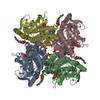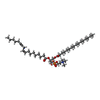[English] 日本語
 Yorodumi
Yorodumi- PDB-8vc2: CryoEM structure of insect gustatory receptor BmGr9 in the presen... -
+ Open data
Open data
- Basic information
Basic information
| Entry | Database: PDB / ID: 8vc2 | ||||||||||||
|---|---|---|---|---|---|---|---|---|---|---|---|---|---|
| Title | CryoEM structure of insect gustatory receptor BmGr9 in the presence of fructose | ||||||||||||
 Components Components | Gustatory receptor | ||||||||||||
 Keywords Keywords |  MEMBRANE PROTEIN / gustatory receptor / MEMBRANE PROTEIN / gustatory receptor /  homotetramer / homotetramer /  ligand-gated ion channel / seven transmembrane ligand-gated ion channel / seven transmembrane | ||||||||||||
| Function / homology | 7TM chemoreceptor / 7tm Chemosensory receptor / sensory perception of taste /  signal transduction / signal transduction /  plasma membrane / Chem-PSC / Gustatory receptor plasma membrane / Chem-PSC / Gustatory receptor Function and homology information Function and homology information | ||||||||||||
| Biological species |   Bombyx mori (domestic silkworm) Bombyx mori (domestic silkworm) | ||||||||||||
| Method |  ELECTRON MICROSCOPY / ELECTRON MICROSCOPY /  single particle reconstruction / single particle reconstruction /  cryo EM / Resolution: 3.98 Å cryo EM / Resolution: 3.98 Å | ||||||||||||
 Authors Authors | Frank, H.M. / Walsh Jr., R.M. / Garrity, P.A. / Gaudet, R. | ||||||||||||
| Funding support |  United States, 3items United States, 3items
| ||||||||||||
 Citation Citation |  Journal: bioRxiv / Year: 2023 Journal: bioRxiv / Year: 2023Title: Structure of an insect gustatory receptor. Authors: Heather M Frank / Sanket Walujkar / Richard M Walsh / Willem J Laursen / Douglas L Theobald / Paul A Garrity / Rachelle Gaudet /  Abstract: Gustatory Receptors (GRs) are critical for insect chemosensation and are potential targets for controlling pests and disease vectors. However, GR structures have not been experimentally determined. ...Gustatory Receptors (GRs) are critical for insect chemosensation and are potential targets for controlling pests and disease vectors. However, GR structures have not been experimentally determined. We present structures of Gr9 (BmGr9), a fructose-gated cation channel, in agonist-free and fructose-bound states. BmGr9 forms a tetramer similar to distantly related insect Olfactory Receptors (ORs). Upon fructose binding, BmGr9's ion channel gate opens through helix S7b movements. In contrast to ORs, BmGR9's ligand-binding pocket, shaped by a kinked helix S4 and a shorter extracellular S3-S4 loop, is larger and solvent accessible in both agonist-free and fructose-bound states. Also unlike ORs, fructose binding by BmGr9 involves helix S5 and a binding pocket lined with aromatic and polar residues. Structure-based sequence alignments reveal distinct patterns of ligand-binding pocket residue conservation in GR subfamilies associated with distinct ligand classes. These data provide insight into the molecular basis of GR ligand specificity and function. | ||||||||||||
| History |
|
- Structure visualization
Structure visualization
| Structure viewer | Molecule:  Molmil Molmil Jmol/JSmol Jmol/JSmol |
|---|
- Downloads & links
Downloads & links
- Download
Download
| PDBx/mmCIF format |  8vc2.cif.gz 8vc2.cif.gz | 277 KB | Display |  PDBx/mmCIF format PDBx/mmCIF format |
|---|---|---|---|---|
| PDB format |  pdb8vc2.ent.gz pdb8vc2.ent.gz | 214.9 KB | Display |  PDB format PDB format |
| PDBx/mmJSON format |  8vc2.json.gz 8vc2.json.gz | Tree view |  PDBx/mmJSON format PDBx/mmJSON format | |
| Others |  Other downloads Other downloads |
-Validation report
| Arichive directory |  https://data.pdbj.org/pub/pdb/validation_reports/vc/8vc2 https://data.pdbj.org/pub/pdb/validation_reports/vc/8vc2 ftp://data.pdbj.org/pub/pdb/validation_reports/vc/8vc2 ftp://data.pdbj.org/pub/pdb/validation_reports/vc/8vc2 | HTTPS FTP |
|---|
-Related structure data
| Related structure data |  43130MC  8vc1C M: map data used to model this data C: citing same article ( |
|---|---|
| Similar structure data | Similarity search - Function & homology  F&H Search F&H Search |
- Links
Links
- Assembly
Assembly
| Deposited unit | 
|
|---|---|
| 1 |
|
- Components
Components
| #1: Protein | Mass: 54572.320 Da / Num. of mol.: 4 Source method: isolated from a genetically manipulated source Source: (gene. exp.)   Bombyx mori (domestic silkworm) / Gene: Gr9 / Production host: Bombyx mori (domestic silkworm) / Gene: Gr9 / Production host:   Homo sapiens (human) / References: UniProt: B3GTD7 Homo sapiens (human) / References: UniProt: B3GTD7#2: Chemical | ChemComp-PSC / (  Phosphatidylcholine PhosphatidylcholineHas ligand of interest | Y | |
|---|
-Experimental details
-Experiment
| Experiment | Method:  ELECTRON MICROSCOPY ELECTRON MICROSCOPY |
|---|---|
| EM experiment | Aggregation state: PARTICLE / 3D reconstruction method:  single particle reconstruction single particle reconstruction |
- Sample preparation
Sample preparation
| Component | Name: Fructose-bound BmGr9 homotetramer / Type: COMPLEX / Entity ID: #1 / Source: RECOMBINANT |
|---|---|
| Molecular weight | Value: 0.21805 MDa / Experimental value: NO |
| Source (natural) | Organism:   Bombyx mori (domestic silkworm) Bombyx mori (domestic silkworm) |
| Source (recombinant) | Organism:   Homo sapiens (human) Homo sapiens (human) |
| Buffer solution | pH: 8.25 |
| Specimen | Embedding applied: NO / Shadowing applied: NO / Staining applied : NO / Vitrification applied : NO / Vitrification applied : YES : YES |
Vitrification | Cryogen name: ETHANE |
- Electron microscopy imaging
Electron microscopy imaging
| Experimental equipment |  Model: Titan Krios / Image courtesy: FEI Company |
|---|---|
| Microscopy | Model: TFS KRIOS |
| Electron gun | Electron source : :  FIELD EMISSION GUN / Accelerating voltage: 300 kV / Illumination mode: FLOOD BEAM FIELD EMISSION GUN / Accelerating voltage: 300 kV / Illumination mode: FLOOD BEAM |
| Electron lens | Mode: BRIGHT FIELD Bright-field microscopy / Nominal magnification: 105000 X / Calibrated magnification: 60240 X / Nominal defocus max: 2200 nm / Nominal defocus min: 800 nm / Alignment procedure: COMA FREE Bright-field microscopy / Nominal magnification: 105000 X / Calibrated magnification: 60240 X / Nominal defocus max: 2200 nm / Nominal defocus min: 800 nm / Alignment procedure: COMA FREE |
| Specimen holder | Cryogen: NITROGEN / Specimen holder model: FEI TITAN KRIOS AUTOGRID HOLDER |
| Image recording | Average exposure time: 3.995 sec. / Electron dose: 80.144 e/Å2 / Film or detector model: GATAN K3 BIOQUANTUM (6k x 4k) / Num. of grids imaged: 1 / Num. of real images: 9002 |
| EM imaging optics | Energyfilter name : GIF Bioquantum / Energyfilter slit width: 20 eV : GIF Bioquantum / Energyfilter slit width: 20 eV |
- Processing
Processing
| EM software |
| ||||||||||||||||||||||||||||||||||||||||||||||||||
|---|---|---|---|---|---|---|---|---|---|---|---|---|---|---|---|---|---|---|---|---|---|---|---|---|---|---|---|---|---|---|---|---|---|---|---|---|---|---|---|---|---|---|---|---|---|---|---|---|---|---|---|
CTF correction | Type: PHASE FLIPPING AND AMPLITUDE CORRECTION | ||||||||||||||||||||||||||||||||||||||||||||||||||
| Particle selection | Num. of particles selected: 1141024 | ||||||||||||||||||||||||||||||||||||||||||||||||||
| Symmetry | Point symmetry : C4 (4 fold cyclic : C4 (4 fold cyclic ) ) | ||||||||||||||||||||||||||||||||||||||||||||||||||
3D reconstruction | Resolution: 3.98 Å / Resolution method: FSC 0.143 CUT-OFF / Num. of particles: 233351 / Symmetry type: POINT | ||||||||||||||||||||||||||||||||||||||||||||||||||
| Atomic model building | B value: 43.02 / Protocol: FLEXIBLE FIT / Space: REAL / Target criteria: cross-correlation coefficient Details: Initial fitting was done using DockInMap in PHENIX and refined through cycles of manual rebuilding in Coot, real-space refinement in PHENIX, and remodeling by simulations run in the ISOLDE plugin of ChimeraX. | ||||||||||||||||||||||||||||||||||||||||||||||||||
| Atomic model building | Details: ColabFold generated / Source name: Other / Type: in silico model | ||||||||||||||||||||||||||||||||||||||||||||||||||
| Refinement | Cross valid method: NONE |
 Movie
Movie Controller
Controller



 PDBj
PDBj

